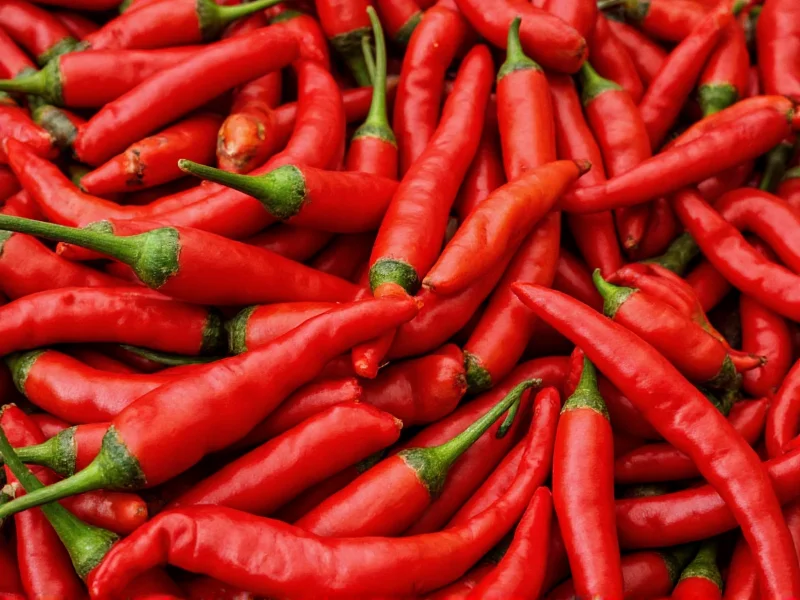The pasilla chili (chile pasilla in Spanish, meaning "little raisin") transforms from fresh chilaca peppers through sun-drying, developing complex flavors essential to traditional Mexican cooking. Unlike fresh peppers, pasillas offer a concentrated, nuanced taste profile that enhances sauces, stews, and marinades without overwhelming heat.
Physical Characteristics of Pasilla Chilies
Pasilla chilies display distinctive visual traits that help differentiate them from other dried peppers:
- Color: Deep brown to nearly black when dried, with a matte finish
- Shape: Long and slender (6-8 inches), often curved with wrinkled skin
- Texture: Thin, brittle walls that crack easily when bent
- Weight: Light for their size due to low moisture content
When selecting pasillas, look for intact peppers without mold or excessive dust. The best specimens have a slightly shiny surface and emit a faint fruity aroma when broken open. Avoid those with white spots (indicating moisture damage) or excessive brittleness (signaling age).
Flavor Profile and Heat Level
Pasilla chilies deliver a sophisticated flavor experience that makes them prized by chefs:
- Primary notes: Dried fruit (raisin, prune), licorice, tobacco, and subtle coffee undertones
- Heat level: 1,000-2,500 Scoville Heat Units (SHU)—milder than jalapeños (2,500-8,000 SHU) but stronger than poblanos (1,000-2,000 SHU)
- Mouthfeel: Smooth, with gradual warmth that builds slowly
Unlike many chilies where heat dominates, pasillas provide balanced complexity. The drying process concentrates natural sugars while developing earthy notes, creating a versatile pepper suitable for both delicate sauces and robust stews.
| Chili Type | Heat Level (SHU) | Flavor Profile | Common Uses |
|---|---|---|---|
| Pasilla | 1,000-2,500 | Dried fruit, licorice, earthy | Moles, salsas, adobos |
| Ancho | 1,000-2,000 | Cherry, cocoa, raisin | Mole poblano, enchilada sauce |
| Mulato | 2,500-3,000 | Chocolate, coffee, sweet | Mole negro, complex sauces |
| Guajillo | 2,500-5,000 | Tangy, berry, tea-like | Adobo sauce, marinades |
Culinary Applications and Traditional Uses
Pasilla chilies shine in traditional Mexican dishes where their nuanced flavor can develop fully:
Moles: Essential in Oaxacan mole negro and other complex sauces, where pasillas contribute deep color and foundational flavor. Their mild heat allows other ingredients like chocolate and spices to shine.
Salsas: When rehydrated and blended, pasillas create smooth, rich salsas perfect for enchiladas or as table condiments. The pasilla salsa recipe typically includes garlic, onion, and sometimes tomatoes.
Adobos: Combined with vinegar and spices, pasilla-based adobos tenderize meats while adding complex flavor without excessive heat—ideal for slow-cooked dishes like chile colorado.
Modern applications: Contemporary chefs use pasillas in unexpected ways—infused into oils, added to chocolate desserts, or blended into coffee rubs for meats.
Pasilla vs Ancho vs Mulato: Understanding the Differences
Many confuse pasilla with ancho and mulato chilies, but key distinctions exist:
Pasilla vs Ancho: Pasillas come from chilaca peppers, while anchos are dried poblanos. Pasillas are longer, thinner, and darker than anchos, with more pronounced fruit notes. Anchos offer sweeter, cherry-like flavors with less complexity.
Pasilla vs Mulato: Mulatos are also dried poblanos but harvested later than anchos. They're darker and sweeter than anchos with chocolate notes, while pasillas maintain more fruitiness. Mulatos generally run slightly hotter than pasillas.
Understanding these differences helps prevent recipe failures—substituting anchos for pasillas in mole negro, for example, creates a noticeably different flavor profile.
Proper Preparation Techniques
Maximize pasilla flavor with correct preparation:
- Stemming and seeding: Cut off the stem, then shake or scrape out seeds. Retain some seeds for extra heat.
- Dry toasting: Briefly toast whole peppers in a dry skillet over medium heat (1-2 minutes) until fragrant but not burnt.
- Rehydration: Soak in hot water for 15-20 minutes until pliable. Reserve soaking liquid for sauces.
- Blending: Blend rehydrated peppers with soaking liquid until smooth for sauces or pastes.
Avoid boiling pasillas, which can make them bitter. For intense flavor, roast rehydrated peppers under the broiler for 2-3 minutes before blending.
Storage and Shelf Life
Pasilla chilies maintain quality when stored properly:
- Keep in airtight containers away from light and moisture
- Ideal storage temperature: below 70°F (21°C)
- Maximum shelf life: 6-12 months for optimal flavor
- Signs of deterioration: loss of aroma, white mold spots, excessive brittleness
For extended storage, freeze dried pasillas in vacuum-sealed bags for up to 2 years. Thaw at room temperature before use to prevent moisture absorption.
Nutritional Benefits
Beyond flavor, pasilla chilies offer nutritional advantages:
- Rich in vitamin C (even when dried)
- Contains capsaicin, which may boost metabolism
- Source of vitamin A, potassium, and antioxidants
- Negligible calories (about 18 per ounce)
While not consumed in large quantities, their inclusion in dishes contributes to overall dietary diversity and potential health benefits associated with moderate chili consumption.
Finding and Selecting Quality Pasilla Chilies
When shopping for pasilla chilies, consider these tips:
- Check for consistent dark color without greenish tints (indicates incomplete drying)
- Choose flexible peppers that don't snap immediately (excessive brittleness suggests age)
- Smell for pleasant, fruity aroma—avoid musty or moldy scents
- Purchase from reputable Mexican markets or specialty spice retailers
- Consider whole peppers rather than pre-ground for maximum freshness
Online retailers often provide fresher pasillas than standard grocery stores, where stock may sit for extended periods. Look for harvest dates when available.











 浙公网安备
33010002000092号
浙公网安备
33010002000092号 浙B2-20120091-4
浙B2-20120091-4